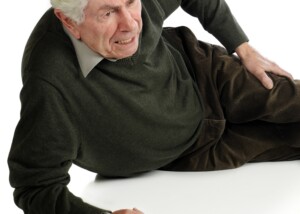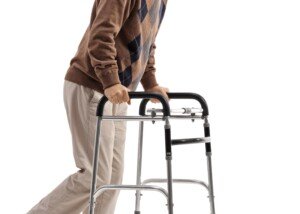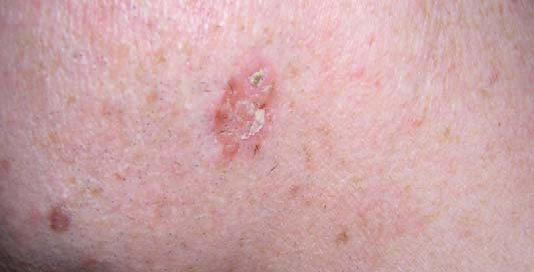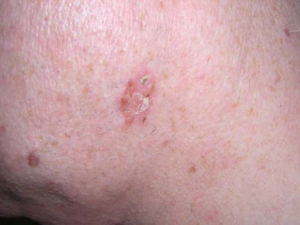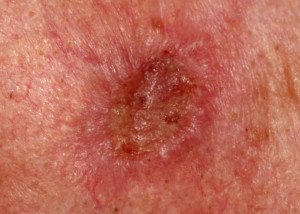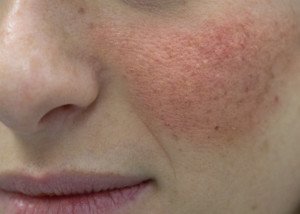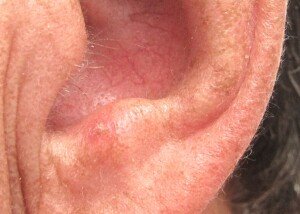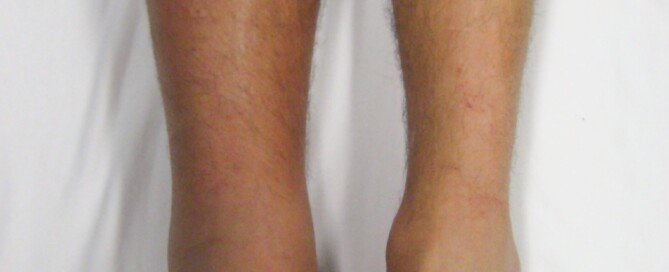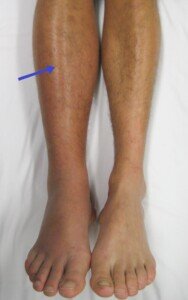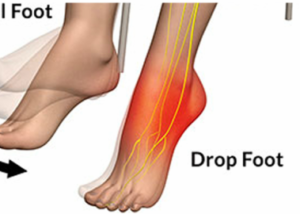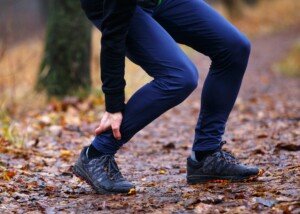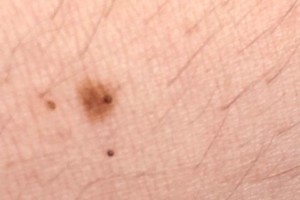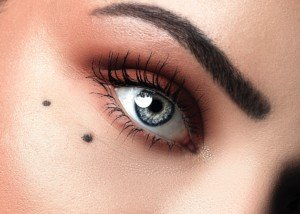Falling from a Standing Position to the Floor in the Elderly
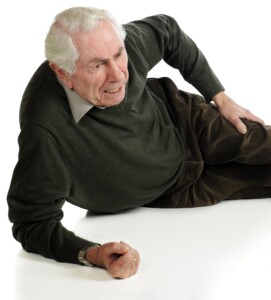
A fall in an elderly person from standing to the ground is deadlier far more often than you may think.
“Slip-and-fall” accidents may be the fodder of reams of personal injury lawsuits, but for the elderly, they are serious business, and fatal significantly more often when compared to non-elderly people, says a study.
When an elderly person takes a fall from a standing position and hits the floor or ground, this can kill them, and if this worries you, don’t let anyone convince you your imagination is overactive.
My father thought my imagination was overactive when I kept expressing concerns about my mother (elderly) taking a fall due to her frequent blackouts while standing (severe orthostatic hypotension).
Well, one day it finally happened (because I wasn’t present to prevent it), and six weeks later, she paid the price in the form of a brain bleed that had to be surgically drained.
A report in The Journal of Trauma: Injury, Infection, and Critical Care stresses the seriousness of short falls in the elderly.
It seems like a no-brainer to say that elderly people are less likely to survive a short fall than are younger individuals.
But the elderly are three times more likely, says the study (over 57,000 patients), to die from a short fall than are people under age 70.
The report points out that short falls should not be underestimated in the elderly, and that about 30% of people over 65 suffer from a fall every year.
What makes the potential for death or permanent disability greater is if the person loses consciousness while standing, and then falls, obviously unable to help break the fall due to lack of awareness. This puts them at very high risk for head injury.
But short falls are still potentially very dangerous for fully conscious victims.
My aunt took a short fall, broke her hip, then succumbed to postsurgical pneumonia.
The study found that about 4.5 percent of elderly individuals died after a short (ground-level) fall, whereas the death figure for those under age 70 was 1.5 percent.
Of survivors, the elderly stayed in the hospital longer, and just 22 percent were able to function independently after discharge. The figure for people under 70 was 41 percent.
Nevertheless, almost 75 percent of elderly people are not severely injured from short falls.
Unfortunately, some elderly people think they’re in this 75 percent group and thus don’t take all the safety precautions they should.
Fall Prevention Tips in Your Home
“Fall-proof your home — remove rugs and obstacles at ground level,” says D’Wan Carpenter, MD, a board certified physical medicine and rehabilitation physician.
“Utilize assistive devices (walker, cane, crutches) and get instruction on proper use from a physical therapist.
“Have vision, hearing and balance assessments at least yearly.
“Get active. As people age they tend to decrease their activity and become sedentary which also increases risk for osteoporosis [brittle bones].”
 Dr. Carpenter is one of the nation’s top board-certified physical medicine and rehabilitation physicians, a national speaker, medical legal expert and independent medical examiner. She is founder and Chief Medical Officer of DJC Physical Medicine Consultants. Follow Dr. D’Wan on Twitter.
Dr. Carpenter is one of the nation’s top board-certified physical medicine and rehabilitation physicians, a national speaker, medical legal expert and independent medical examiner. She is founder and Chief Medical Officer of DJC Physical Medicine Consultants. Follow Dr. D’Wan on Twitter.
 Lorra Garrick is a former personal trainer certified through the American Council on Exercise. At Bally Total Fitness she trained women and men of all ages for fat loss, muscle building, fitness and improved health.
Lorra Garrick is a former personal trainer certified through the American Council on Exercise. At Bally Total Fitness she trained women and men of all ages for fat loss, muscle building, fitness and improved health.
.
Top image: Shutterstock/glenda
Source: sciencedaily.com/releases/2010/11/101101130135.htm
If You’re a Slow Walker Will this Shorten Your Lifespan?

Slow walking in daily life may increase mortality risk in older people.
Years ago I worked in a department with many people over age 55. I confess: I had no tolerance for slow walkers, as they headed out of the department for lunch break, me stuck behind them in the narrow hall.
I was never ahead of them because my workstation was far from the exit, while theirs was much closer.
Getting stuck behind these slow walkers cost me time on my lunch break; when you have a 35 minute lunch break, every single minute counts.
Faster walking speed correlates to longer lifespan, says a report in the Journal of the American Medical Association.
Though the JAMA study focuses on older adults, it stands to reason that if you want to be a brisk walker in older age, you should begin walking fast when you’re younger.
I’m flabbergasted at how so few younger adults have a perk in their step. I would tell even my younger personal-training clients to make a habit of walking at a quick pace in daily life, even if it was just a short distance from their parked car to the entrance of a store.
Walking Speed and Survival
Stephanie Studenski, MD, led the study of 34,485 adults over age 65.
The analyses, which covered many years, revealed that walking speed was associated with variations in the likelihood of survival at all ages in men and women, but was particularly correlative over age 75.
“Predicted years of remaining life for each sex and age increased as gait speed increased, with a gait speed of about 0.8 meters [2.6 feet]/second at the median [midpoint] life expectancy at most ages for both sexes,” says the report.
Another finding was that when survival was predicted based upon gender, age and walking speed, this was just as accurate as predicting mortality based upon gender, age, self-reported function, chronic conditions, blood pressure, smoking and body mass index.
Why does walking speed predict mortality?
The paper points out that walking requires energy and control of movement, imposing demands on various bodily systems.
A person who walks slowly may have damaged organs. (But I’m betting that slow older walkers were also slow when they were young. After all, do slow young walkers turn into fast older walkers?)
As a fitness expert, I propose an additional explanation: If you don’t use it you’ll lose it.
Nevertheless, at a minimum, making a habit of walking briskly in daily life will certainly make it easier for you to move fast when you have to.
You won’t get fatigued or feel exhausted after doing a lot of required fast walking if your body is already used to this.
 Lorra Garrick has been covering medical, fitness and cybersecurity topics for many years, having written thousands of articles for print magazines and websites, including as a ghostwriter. She’s also a former ACE-certified personal trainer.
Lorra Garrick has been covering medical, fitness and cybersecurity topics for many years, having written thousands of articles for print magazines and websites, including as a ghostwriter. She’s also a former ACE-certified personal trainer.
.
Top image: ©Lorra Garrick
Actinic Keratosis Appearance vs. Squamous Cell Carcinoma
Actinic keratoses and squamous cell carcinoma can look similar; in fact, an actinic keratosis can turn into a squamous cell carcinoma.
Some doctors even believe they are one and the same, just at different points along the continuum.
Squamous cell carcinoma is the second-most common skin cancer. About 3,500 people in the U.S. die from it every year.
This skin malignancy grows slowly, but the deadliness lies in the delayed diagnosis.
The delay means that five percent of squamous cell carcinoma spreads, and this is what makes it lethal. As it grows locally, the destruction can become quite gruesome.
How common is squamous cell carcinoma?
Every year in the U.S. there are 250,000 new cases. Though this disease is strongly tied to sunlight exposure and usually grows in heavily exposed areas to the sun such as the face, scalp and limbs, it can actually grow in dark areas such as under the tongue.
Skilled Mimicker of Normal Aging Skin
Squamous cell carcinoma often initially masquerades as what many people might pass off as benign aging of the skin.
People may see that slowly developing dark pink, scaly patch of skin as a harmless consequence of getting older, or even harmless sun damage or the non-cancerous but abnormal actinic keratosis.
The individual may end up completely ignoring the stealthy growth, becoming desensitized to it, especially if he or she has already been diagnosed with similar-looking benign growths. Skin cancer never enters their minds.
The diagnosis of squamous cell carcinoma is on the rise in people under 45.
What Squamous Cell Carcinoma Looks Like
- Patchy area of skin, reddish or pink in color.
- Often scaly and/or crusty. The crust may be some shade of brown or brownish yellow.
- May also take the form of unsightly nodules or very raised bumps, sometimes with a horn-like structure sticking out of them.
- If growth is allowed to progress enough, the area can become quite “gross” in appearance.
Actinic keratosis (below), which is very common, results from sun damage, and if left untreated, 5-10 percent of these morph into squamous cell carcinoma.
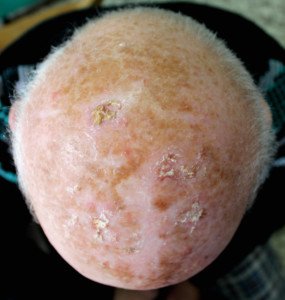
Shutterstock/Dermatology11
I asked Jason Lupton, MD, how a doctor can tell the difference between actinic keratosis (which many people have but don’t realize it) and early squamous cell carcinoma.
Dr. Lupton is a board certified dermatologist practicing in the San Diego, CA area.
Dr. Lupton: Sometimes it is hard to distinguish between AK and early SCC. This is sometimes determined by response to treatment — if a lesion responds to basic treatment — liquid nitrogen or topical therapies — then a further pursuit is unnecessary.
If it does not, then the lesion is biopsied to determine if it has changed over into a squamous cell carcinoma.
Typically SCC’s feel more pronounced, a little bumpier, rougher and bleed more easily and are just more “hearty” lesions — although again, this is not exact.
A squamous cell carcinoma is also more likely to be tender or feel — to the fingertips — as though it has some substance beneath it.
Can squamous cell carcinoma develop from a mole?
I have never heard of an SCC developing from a mole. It derives from the squamous epithelium. They are different entities.
Since squamous cell carcinoma is tied to sun exposure, how is it that it can develop inside the mouth or anus?
SCC is related to sunlight exposure, but in those other areas it is associated with preceding HPV infections. So sunlight is not everything with this type.
If you suspect you have only an actinic keratosis, you should see a dermatologist just to be sure.
To prevent this from morphing into squamous cell carcinoma, your doctor will spray it with liquid nitrogen which should kill the atypical cells. If there’s no response, a prescription cream can be applied.
 Dr. Lupton specializes in skin cancer prevention and treatment plus minimally invasive cosmetic procedures including mole removal, skin rejuvenation, wrinkle reduction and acne treatment.
Dr. Lupton specializes in skin cancer prevention and treatment plus minimally invasive cosmetic procedures including mole removal, skin rejuvenation, wrinkle reduction and acne treatment.
 Lorra Garrick has been covering medical, fitness and cybersecurity topics for many years, having written thousands of articles for print magazines and websites, including as a ghostwriter. She’s also a former ACE-certified personal trainer.
Lorra Garrick has been covering medical, fitness and cybersecurity topics for many years, having written thousands of articles for print magazines and websites, including as a ghostwriter. She’s also a former ACE-certified personal trainer.
DVT Treatment: Blood Thinner vs. Removal with a Catheter
Which is better for DVT treatment: a blood thinner drug or catheter-based removal?
A Temple University School of Medicine study involving 90,000 patients has an interesting conclusion.
The mortality rate between the two DVT treatments is the same. However, the catheter procedure brings more risk of bleeding.
This, however, is not related to the efficacy of the catheter treatment as far as removing the blood clot.
What is the catheter-based treatment for deep vein thrombosis?
This minimally invasive procedure involves catheter insertion through veins to deliver a clot-busting drug right at the site of the DVT.
This procedure costs more than anticoagulant therapy (blood thinner) and requires more days in the hospital.
Within 30 days of diagnosis, about six percent of patients with a DVT die.
In these cases, the blood clot breaks loose and travels to the lung (where it’s now known as a pulmonary embolism), cutting off oxygen supply.
Despite 90,000 cases being involved in this research, it was considered too small for any rock-solid conclusions to be drawn regarding the safety of the catheter-based therapy vs. anticoagulants alone for the DVT treatment.
Blood Thinning Drugs
The study might have you wondering about the use of blood thinning drugs for treating a DVT that’s already present.
“Blood thinners (anticoagulants) prevent formation of a new clot; they do not dissolve the clot,” points out Dr. Paramjit “Romi” Chopra, MD, founder of the Midwest Institute for Minimally Invasive Therapies (MIMIT), an interventional radiology and endovascular therapy practice.
“Catheter directed thrombolysis (removal of clot) is required in cases where the clot burden is extensive and the body’s natural mechanisms cannot dissolve it.
“We want to avoid chronic DVT and the post-phlebitic syndrome.”
Catheter-directed thrombolysis (thrombolysis = breaking up a blood clot) leads to a big reduction in the chances of developing this post-thrombotic or phebitic syndrome, an often debilitating condition of the legs.
PTS, a painful condition, is more likely to occur in patients for whom the clot occurs above knee level, particularly in the hip and groin area.
The American College of Chest Surgeons favors drugs alone, while the American Heart Association favors the catheter procedure — at least for people at low risk for bleeding.
Dr. Chopra combines his Eastern roots and 30+ years’ Western experience to unify the best of both worlds at MIMIT to treat venous disease, peripheral artery disease and musculoskeletal disease.
combines his Eastern roots and 30+ years’ Western experience to unify the best of both worlds at MIMIT to treat venous disease, peripheral artery disease and musculoskeletal disease.
 Lorra Garrick has been covering medical, fitness and cybersecurity topics for many years, having written thousands of articles for print magazines and websites, including as a ghostwriter. She’s also a former ACE-certified personal trainer.
Lorra Garrick has been covering medical, fitness and cybersecurity topics for many years, having written thousands of articles for print magazines and websites, including as a ghostwriter. She’s also a former ACE-certified personal trainer.
.
Top image: James Heilman, MD, CreativeCommons
Source: sciencedaily.com/releases/2014/07/140721182031.htm
Strip Off Belly Fat: Cardio Exercise or Lifting Weights?

If you want to lose stomach fat and had to choose between cardio or lifting weights, which should you choose?
According to a Duke University Medical Center study, cardio wins for reducing belly size. But there’s probably a huge catch — which I’ll get to shortly.
The fatty tissue at issue here is that of visceral and liver; it’s deep within your abdominal cavity and raises the risk for heart disease and type 2 diabetes.
“Our study sought to identify the most effective form of exercise to get rid of that unhealthy fat,” says Duke University exercise physiologist Cris Slentz, Ph.D., the study’s lead author, in the report.
The study showed that to lose stomach fat, aerobics was actually more effective than lifting weights.
Lifting weights (strength training), according to the study, resulted in no significant results for midsection shrinkage.
Surprisingly, a combination of cardio and weight lifting to lose stomach fat didn’t make much of a difference when compared to just the cardio alone.
Slentz explains, “Resistance training is great for improving strength and increasing lean body mass, but if you are overweight, and you want to lose belly fat, aerobic exercise is the better choice because it burns more calories.”
These results beg the question: What KIND of strength training did the subjects undergo?
The study summary doesn’t mention this. However, what’s really telling is that the subjects were overweight and sedentary.
This tells me that they most likely performed single-joint, “isolation” exercises at submaximal intensity — perhaps at the moderate level range of effort.
In short, it is extremely unlikely that out-of-shape, inactive people, who have no experience with lifting weights, did intense sets of deadlifts, barbell squats and bench presses for a stomach weight loss study.
For the Duke study, there were three groups: cardio, weight lifting, and a combination.
The cardio group did the equivalent of 12 miles of jogging a week, 80 percent max heart rate. The weight lifting group did three sets of 8-12 repetitions, three times a week.
To lose stomach fat: the big questions:
- Were these sets taken to muscle failure?
- Or even near muscle failure?
- Or were the sets only of moderate challenge?
- Did they use light, medium or heavy resistance?
- How much rest was taken in between sets?
- Were these triceps kickbacks or barbell presses?
- Arm curls or lat pull-downs?
There are many possibilities here, and all influence how many calories are burned – during, and after, the workouts.
Was the strength training intense enough to keep resting metabolic rate elevated for hours after the workout?
Was the weight lifting protocol conducive to elevating the body’s release of human growth hormone and testosterone – two very powerful fat-burning chemicals? Something tells me a big fat “No.”
To lose stomach fat, strength training with compound routines, done intensely, will blast off more stored energy than cardio that equates to 12 miles of jogging a week at 80 percent max heart rate.

Freepik.com/pressfoto
Intense weight lifting, focusing on the “big lifts” like squats, leg presses, deadlifts, chest presses, pull-ups and rows, will burn significant amounts of stomach fat (and blub all over).

George Stepanek, CreativeCommons
I have seen this in my own clients. So what should be the final verdict when it comes to how to best lose stomach fat?
To lose stomach fat in the most effective way, do both cardio and lifting weights.
But if you’re a novice at strength training, I don’t recommend you attempt heavy, intense deadlifts or heavy squats.
A beginner who wishes to lose stomach fat needs to build up some conditioning and joint integrity before tackling intense, heavy compound routines.

Jasminko Ibrakovic
So to lose stomach fat, begin your journey by doing compound routines with light weights.
To lose stomach fat most successfully, increase weight as you get stronger and keep pushing.
Add cardio to that and you have a winning combination to lose stomach fat.
 Lorra Garrick is a former personal trainer certified through the American Council on Exercise. At Bally Total Fitness she trained women and men of all ages for fat loss, muscle building, fitness and improved health.
Lorra Garrick is a former personal trainer certified through the American Council on Exercise. At Bally Total Fitness she trained women and men of all ages for fat loss, muscle building, fitness and improved health.
.
Top image: Shutterstock/Sinelev
Fat-Burning Cardio Exercises You Can Do with Sprained Ankle

Don’t let a sprained ankle stop you from doing cardio exercise that burns fat.
First of all, make sure your sprained ankle is only that; no broken bones.
Make sure it is securely stabilized with a compression bandage. Compression bandages expedite healing of this injury.
Obviously, the cardio exercise that comes to mind for people with sprained ankles is the stationary bike, but there are other cardio modalities as well, and I’ll get to those shortly.
I’m a former personal trainer who’s had her share of sprained ankles.
I never let my sprained ankles stop me from doing aerobic exercise, and you shouldn’t either.
Pedaling Machines: Do HIIT
When using the stationary bike, if possible, strap both feet into the pedals, and employ a fat-burning technique known as high intensity interval training.
It’s possible to use an elliptical machine while recovering from an injured ankle — but keep the injured foot flat on the pedal pad at all times. Again, employ the fat-burning technique of HIIT.

Freepik.com/jcomp
Note: If at any time, a cardio routine starts aggravating your sprained ankle, stop the exercise.
The cardio exercises mentioned in this article have the potential to allow you to work out, without aggravating your injured foot.
Another fat-burning, cardio-based exercise you can do without compromising your ankle is that of standing in place and socking away at a heavy bag.
Make sure your ankle is securely taped and, ideally, in a brace. Of course, stop if your foot begins hurting.

Shutterstock/Dmitry Kalinovsky
If you know how to deliver punches, believe me, this will definitely count as cardio exercise and burn fat: hooks, crosses and uppercuts, as hard as you can and/or as quickly as you can, will elevate the heart rate and burn fat.
Ever see people sitting on the floor in a machine and rowing? This is safe for sprained ankles and will have a cardio effect.

Freepik.com/pressfoto
Rowing machines have adjustable settings; find the settings that will get your heart really pumping and your breathing going, and this will burn fat.
“Pedaling and rowing with a taped/braced ankle is safe, as long as the individual knows to exercise up to his/her tolerance level,” says Dr. Bruce Pinker, DPM, who specializes in sports medicine and surgery of the foot and ankle.
“Meaning, if the ankle becomes painful, he/she may need to slow down or stop.”
Always ice your sprained ankle after any kind of workout, and for a total of three or four times a day, 20 minutes maximum.
And remember, if there is any pain while exercising, stop immediately.
 Dr. Pinker is with Progressive Foot Care, which provides state-of-the-art, full diagnostic testing and treatment of the foot. He’s a professional foot and ankle health and wellness speaker who delivers many original seminars annually such as “Keep On Running.”
Dr. Pinker is with Progressive Foot Care, which provides state-of-the-art, full diagnostic testing and treatment of the foot. He’s a professional foot and ankle health and wellness speaker who delivers many original seminars annually such as “Keep On Running.”
 Lorra Garrick is a former personal trainer certified through the American Council on Exercise. At Bally Total Fitness she trained women and men of all ages for fat loss, muscle building, fitness and improved health.
Lorra Garrick is a former personal trainer certified through the American Council on Exercise. At Bally Total Fitness she trained women and men of all ages for fat loss, muscle building, fitness and improved health.
Top image: Shutterstock/fongbeerredhot
Best Organic Chocolate Milk: Promised Land, Horizon or Organic Valley?

Which brand of organic chocolate milk tastes the best? There are three popular “natural” brands that are sold at Whole Foods.
One is Horizon Organic. One is Organic Valley. And the other is Promised Land Midnight Chocolate Reduced Fat 2 % Milk.
However, there is no organic label on the Promised Land milk, but I’m including it here because they use hormone-free cows.
By far, the best tasting of these milks is the Promised Land. I am not kidding.
Both Horizon Organic and Organic Valley (at least the reduced fat varieties; I didn’t try the full fat varieties) leave a very unpleasant aftertaste.
The milk comes in a carton for these two brands, and I had briefly speculated that perhaps the milk was picking up some cardboard residue from the carton, causing the miserable aftertaste.
But if this is true, then how come I never detect any aftertaste in white milk by the same brands?
So I ruled out the carton. It’s the chocolate milk itself. The initial taste is okay. Nothing great. And then the aftertaste hits you.
Now, when you drink the Promised Land Midnight Chocolate, WOW! The flavor is much richer than the Organic Valley and Horizon Organic.
There is just no comparison. In fact, Organic Valley and Horizon Organic taste identical, both having the same aftertaste.
Promised Land Midnight Chocolate was previously sold in glass bottles, and now the bottles are plastic, and I’m telling you, THIS is the chocolate milk for health-conscious people.
Though it’s not organic, it’s still hormone free, and besides, if you’re hell-bent on drinking only organic chocolate milk, you just won’t get the same cocoa flavor experience with the organic brands, and the aftertaste is a complete turn-off.
It wasn’t a bad batch, either, because I purchased both cartooned brands on several occasions, initially thinking it’s just a bad batch. But each time, that aftertaste was there. Forget it.
The interesting thing about Promised Land is that their 2 percent variety actually tastes more chocolaty than the full fat version.
If you’re a true chocoholic like me, you’ll want to add chocolate syrup to the Promised Land Midnight chocolate milk, and Whole Foods sells organic chocolate syrup.
Go one step further and add chocolate ice cream! Now THAT’S a REAL chocolate milkshake!
While I’m at it, Promised Land Midnight also beats the taste of conventional chocolate milks sold at regular grocery stores, hands down.
 Lorra Garrick has been covering medical, fitness and cybersecurity topics for many years, having written thousands of articles for print magazines and websites, including as a ghostwriter. She’s also a former ACE-certified personal trainer.
Lorra Garrick has been covering medical, fitness and cybersecurity topics for many years, having written thousands of articles for print magazines and websites, including as a ghostwriter. She’s also a former ACE-certified personal trainer.
Best Hot Chocolate Mix in the World: Silly Farms

Don’t let the name fool you: Silly Farms hot chocolate mix (there are several varieties) is absolutely the best tasting hot chocolate mix you’ll ever find.
I discovered Silly Farms hot chocolate mix at Whole Foods one day, and was attracted to the glass milk jug bottle.
Of course, I’m smarter than to buy a product based on its packaging, but I’ll admit, the compact glass bottle was inviting, and the chocolate powder was visible. I couldn’t say no.
I’m glad I fell for the packaging gimmick because this hot chocolate was the best I had ever tasted in my entire chocoholic life. Silly Farms makes three hot chocolate flavors: “chocolate chocolate,” “chocolate mousse” and “chocolate marshmallow.”
I’ve tried only the first two (don’t care for marshmallows), and I don’t know if there’s any difference in taste, but Silly Farms is now No. 1 on my list as to who makes the best hot chocolate mix.
Now, here is what I do not understand: the ingredients. I have the ingredients tag for only the “chocolate chocolate,” but I’m sure that these ingredients are pretty similar to those of the other flavors.
The ingredients are as follows: natural cane sugar, Dutch processed cocoa (with alkalai), and natural vanilla powder.
That’s it. I expected a bunch of scary ingredients to make this product taste so good. So I’m stunned that this is all there is.
I assume that maybe the “natural vanilla powder” is what gives this product its kick, but the kick is a rich chocolate flavor. So I don’t know how anything vanilla can produce this result.
Now, get this: The stated serving size is only two teaspoons! Come on, who takes only two teaspoons for hot chocolate?
Silly Farms, like just about every food company out there, uses the gimmick of crazy-small serving sizes to create the illusion that the product isn’t that caloric or fattening.
Well, I can’t be fooled by this age-old trick. Two teaspoons of this wonderful powder is 80 calories. I use four TABLEspoons per 8 ounces of hot milk – and that’s a minimum.
Total fat in the two teaspoons is 1.5 grams. One of those grams is saturated. Total carbs is 17 grams. Dietary fiber is one gram, and sugar is 17 grams.
The time to be health conscious is not when you’re drinking hot chocolate. However, I am very pleased that Silly Farms doesn’t add soy to their product. That’s what I was worried about. Thank goodness it’s free of soy – at least according to the label.
The caveat with Silly Farms hot chocolate mix is the shape of the bottle. It looks great on the shelf, but in terms of practicality, it misses. The opening is very small, like a classic glass milk bottle, and the bottle gets wider towards the bottom.
My tablespoon will not fit into the opening. So I must pour the powder into my tablespoon to get the amount just right for my taste preference.
The powder often “sticks,” so what happens is that nothing comes out. I shake a little harder and wham, a pile plops out.
Thus, I must do this over a plate to catch the excess powder.
But this won’t stop me from buying the best hot chocolate mix in the world.
 Lorra Garrick has been covering medical, fitness and cybersecurity topics for many years, having written thousands of articles for print magazines and websites, including as a ghostwriter. She’s also a former ACE-certified personal trainer.
Lorra Garrick has been covering medical, fitness and cybersecurity topics for many years, having written thousands of articles for print magazines and websites, including as a ghostwriter. She’s also a former ACE-certified personal trainer.
Will Daily Aspirin Help Prevent a Stress Heart Attack?

It seems logical that a chronically stressed person could benefit from a daily aspirin in terms of helping prevent a heart attack, since aspirin is a blood thinner and stress thickens blood.
I wondered about this, so I asked a cardiologist if a healthy person under persistent stress should take that daily aspirin.
“It really depends on the risk factors of the patient,” says Pilar Stevens-Cohen, MD, FACC, Department of Cardiology, South Nassau Communities Hospital.
“For the reduction of myocardial infarctions [heart attacks] in men between 45-79, it is recommended if any of the risk factors exist: diabetes, hypertension, smoking, high cholesterol.
“For women between 55-79 there is no data to support primary prevention and aspirin use for myocardial infarction.
“There is an associated reduction in ischemic strokes if any of the following risk factors exist: atrial fibrillation, hypertension, smoking, diabetes, left ventricular hypertrophy.
“Taking baby aspirin in the absence of any risk factors probably doesn’t prevent a primary event, but may increase risk of GI bleeding.”
Chronic stress makes the blood thicker and stickier.
This is because the body, when faced with persistent anxiety, “thinks” that a threatening event is imminent.
Should the body get gashed in a fight or flee situation, thick, sticky blood will clot a lot faster than thinner blood—preventing a fatal hemorrhage!
The intense exertion of a fight or escape from the threat produces hormones that reverse this thickening.
However, for most people, that fight or flight is not possible (e.g., being trapped in a stressful job all day long). Thus, the blood remains chronically thickened—more likely to form clots…and one of these can form in the heart…
However, Dr. Stevens-Cohen explains, “In the average patient, even a patient who leads a very stressful life, there is no benefit to taking a baby aspirin in preventing MI.
“The studies simply don’t support it. While it may not be harmful, it is not considered protective at this time.
“When I was a resident, every patient with one or more cardiac risk factors was placed on ASA 81 mg for MI prevention (let’s forget stroke for now).
“Then studies were released showing that the incidence of MI was actually similar in patients taking ASA vs. not in this population.
“Keeping in mind, this study population had cardiac risk factors and there was no benefit (in particular with women).
“So now, let’s lower the threshold and say no risk factors at all in a heart healthy patient with chronic stress. There is no evidence to support daily aspirin would be protective.
Chronic stress may lead to anxiety, variations in blood pressure, lack of sleep and overall decrease in general health.
“Targeting the specific pathology that impacts a patient’s life may be more beneficial than generic baby aspirin for all.”

Dr. Stevens-Cohen is board certified in cardiology, nuclear cardiology, echocardiography and internal medicine.
 Lorra Garrick has been covering medical, fitness and cybersecurity topics for many years, having written thousands of articles for print magazines and websites, including as a ghostwriter. She’s also a former ACE-certified personal trainer.
Lorra Garrick has been covering medical, fitness and cybersecurity topics for many years, having written thousands of articles for print magazines and websites, including as a ghostwriter. She’s also a former ACE-certified personal trainer.
.
Top image: Freepik.com
Mole with New Black Specks May Not Be Melanoma
Here’s a benign explanation for why you see new black spots in your mole that weren’t there before.
Before I give this explanation, you should know that the new appearance of black in a pre-existing mole can mean melanoma.
However, don’t panic yet if you’ve discovered a new black spot or speck or two in a pre-existing mole.
This is what happened to me. I have a prominent mole on my shin — prominent in that it’s obvious, a medium dark brown and extremely easy to closely inspect, due to its location.
One day I looked at it and saw three tiny specks of black that were not always there.
I lightly rubbed my finger on it to see if the spots might come off, since I supposed that it was some kind of dirt.
But they remained in place. This was pretty scary. Everything else, however, about the mole, appeared unchanged.
I then shaved my legs. I lightly grazed the razor up my entire shin, over the mole just once (very lightly at this point), in the manner that I’ve always done.
Then I rinsed the cream off and let my leg dry. I then inspected the mole: The black spots were completely GONE.
Does this mean I shaved off the part that was melanoma?
Or could it have been very tiny fibers from the black sweat pants that I had slept in overnight, that I had taken off before inspecting my legs?
I had a visit already scheduled later that day with a dermatologist, for my third serial digital dermoscopy appointment.
This is a teaching hospital, so the first person to examine me was a dermatology resident.
I told him about the mole.
He examined it with a dermatoscope and said it looked benign, that the “reticular pattern” was normal.
Then, the actual dermatologist said it looked normal.
I already had nine moles in the hospital’s digital dermoscopy database, but they decided to include this mole as well.
The computer analysis showed that it was normal. In fact, the doctor told me I could wait two years before coming in again because everything was “so stable.”
How would minute fibers from my black sweat pants or any black micro-debris just happen to find their way into a single mole?
“If a mole has black specks on the surface that easily wash off, this should not be of concern for melanoma,” says Emily de Golian, MD, a board certified dermatologist with Forefront Dermatology in Atlanta, GA.
“Just like any other location on the skin, dirt may adhere to a mole and is easily removed with soap and water.
“If, however, dried blood [which can appear as black specks] is present on the surface of a mole, the mole should be evaluated by a board certified dermatologist.
“Moles may bleed due to trauma, which is not inherently bad, but if a mole has developed spontaneous bleeding, this could be a sign that the mole cells are atypical and need to be removed.
“Dried blood will often appear red or dark red when moistened and removed with a white towel or tissue, so this may help distinguish what type of substance is being removed from the mole surface.”
I had not checked the skin elsewhere on my legs for any fibers, so for all I know, they were elsewhere, and would have been difficult to spot without getting close up, and impossible to spot on the back of my legs. But fibers can get anywhere.
Irritated Mole Quickly Develops Black Spot
The image at the very top of this article shows a mole that rapidly developed a dark spot in it.
The cause was aggressive rubbing with a finger to see if a slightly darker area on the left was dirt (which it turned out wasn’t).
My aggressive rubbing irritated the mole plus the surrounding skin, resulting in three dark specks (tiny skin bleeds).
These tiny scabs persisted for a few weeks.
Below is the same mole, but the dark speck that had been in it had become dislodged and ended up loosely sitting on the skin next to it. The two other specks eventually fell off as well.
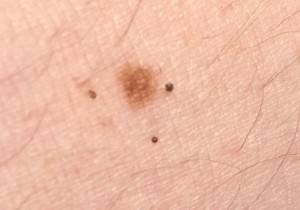
If you notice new black specks or spots in a mole, don’t try to pick them off. And don’t panic.
Take a normal shower and see if the water rinses them away.
If not, wait several more days to even a few weeks to see if they just naturally fall out. If they don’t, see a dermatologist.
 Dr. de Golian focuses on the surgical treatment of skin cancer via Mohs surgery, cutaneous oncology (melanoma and basal cell carcinoma), surgical defect reconstruction and cosmetic dermatology.
Dr. de Golian focuses on the surgical treatment of skin cancer via Mohs surgery, cutaneous oncology (melanoma and basal cell carcinoma), surgical defect reconstruction and cosmetic dermatology.
 Lorra Garrick has been covering medical, fitness and cybersecurity topics for many years, having written thousands of articles for print magazines and websites, including as a ghostwriter. She’s also a former ACE-certified personal trainer.
Lorra Garrick has been covering medical, fitness and cybersecurity topics for many years, having written thousands of articles for print magazines and websites, including as a ghostwriter. She’s also a former ACE-certified personal trainer.
Fading Moles: Melanoma, or Could This Be Something Else Besides Skin Cancer?



